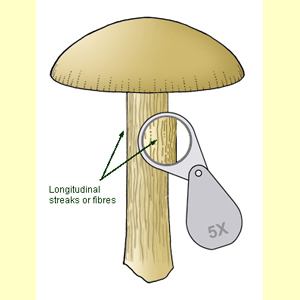
The texture of the stipe as viewed through a x5 hand lens. Some surface features are easily lost on handling, so when observing the stipe surface pick up the fruit-body by the base of the stipe, or the edge of the pileus. Hold the stipe up to the light to accentuate any hairs projecting in silhouette from the surface. The extreme base or apex of the stipe may have more pronounced surface features than the middle portion. Observe the middle portion of the stipe for this feature. Ridges or scales at the very base of the stipe are usually part of the Volva.
Choose this state if: there are fine to coarse fibres on the stipe surface which are more or less flat on the surface (although the ends may be upturned in places). The fibres are oriented longitudinally and are more or less parallel. When the fibres are fine, the stipe surface often has a silky sheen. When the fibres are coarse, the stipe surface may appear striped. If you are straining to see individual fibres under the hand lens, choose the smooth option.
